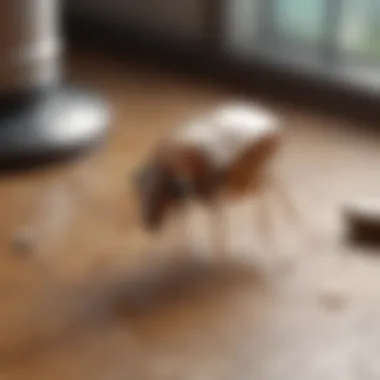Understanding How Fleas Enter Homes: Pathways & Prevention


Intro
Fleas are small yet persistent pests that can turn a comfortable home into a troubled living space. Understanding how they breach our defenses is vital for effective management and extermination. Rather than simply addressing a flea infestation after it occurs, gaining insight into their behavior and ecology can provide homeowners with the tools necessary to prevent such intrusions effectively.
Fleas are not just a nuisance; they can also pose health risks for pets and humans alike. This article explores the various pathways through which fleas can invade our homes. By examining their behavioral attributes, ecological requirements, and potential entry points, homeowners can develop strategies to maintain a pest-free environment.
In the sections that follow, we will delve into the habits of fleas, the conditions they thrive in, and the effective measures that can be taken to minimize their presence around our living spaces. This will offer readers a well-rounded understanding of fleas and ways to mitigate infestations.
Prelude to Fleas
Fleas are more than just a nuisance; they represent a significant challenge for homeowners trying to maintain a healthy living environment. Understanding the behavior and characteristics of fleas can provide essential insights into how they invade homes. This section lays the groundwork for discussing their biological aspects and types, which helps us to better approach prevention and control.
Fleas are small, flightless insects that feed on the blood of mammals and birds. Given their parasitic nature, they can easily infiltrate homes, often hitching rides on pets or riding the currents of the wind. When discussing fleas, one must consider their reproductive capabilities. A single pair of fleas can produce thousands of eggs in a short period. Therefore, knowledge of flea biology is critical for timely intervention.
The various types of fleas that exist also warrant attention. Understanding these different species aids in identifying specific infestations and adopting appropriate management strategies. Since different types of fleas may have unique characteristics and behaviors, awareness of their presence can vastly improve our chances of preventing them from becoming unwanted houseguests.
"Understanding flea biology is the first step in effective pest control."
In summary, this section on fleas not only prepares the reader for an in-depth analysis but also underscores the relevance of early detection and effective measures against flea infestations. The following sections delve into the specific details regarding flea biology and the common types of fleas, setting the stage for a comprehensive examination of this pervasive issue.
Understanding Flea Biology
Fleas belong to the order Siphonaptera, characterized by their laterally compressed bodies and strong hind legs, which allow them to jump considerable distances in relation to their size. At a mere couple of millimeters in length, they can leap up to 200 times their body length, which aids them in evading capture and finding hosts.
Their lifecycle stages—eggs, larvae, pupae, and adults—play pivotal roles in understanding their proliferation. The adult flea is often the least of a homeowner's worries; the real challenge lies in the early stages of development. Moreover, fleas are adept at survival, with the ability to remain dormant for extended periods until environmental conditions become favorable for their emergence.
The feeding habits of fleas are also noteworthy. They possess specialized mouthparts that enable them to pierce skin and ingest blood, which is necessary for their reproduction. This aspect of their biology has direct implications on the health of pets and humans alike, often resulting in discomfort and potential disease transmission.
Common Types of Fleas
There are several types of fleas, but two primarily concern homeowners: the cat flea and the dog flea. While they are named for their most common hosts, these creatures do not discriminate.
- Cat flea (Ctenocephalides felis): This species is the most common flea in homes. It can infest both cats and dogs, as well as humans. Cat fleas thrive in warm, humid conditions and are particularly adept at infesting carpets and upholstery.
- Dog flea (Ctenocephalides canis): While not as prevalent as the cat flea, the dog flea primarily affects dogs. Its habits and lifecycle are similar to those of the cat flea.
Less common species include the human flea and the bird flea, which are primarily found in specific circumstances. However, the methods of entry and infestation remain similar regardless of the flea type.
In understanding these common types of fleas, homeowners can better target their pest control measures and direct their efforts towards specific life stages and species, greatly improving their chances of successful flea management.
Flea Life Cycle
Understanding the flea life cycle is crucial for homeowners who wish to prevent and control infestations. Fleas undergo a transformation comprising several distinct stages: egg, larva, pupa, and adult. Each of these phases has specific characteristics that affect their ability to invade your living space. By knowing the life cycle, individuals can better manage prevention strategies and respond effectively if an infestation occurs.
Egg Stage
Flea eggs, which are typically laid by adult fleas, are tiny, oval, and about 0.5 millimeters in length. A female flea can lay up to 50 eggs each day, leading to rapid population growth. The eggs are usually deposited in the host's fur, but they can fall off into the environment, particularly around pet bedding and carpets.
These eggs are not sticky, allowing them to easily scatter throughout the house. The eggs hatch within one to ten days, depending on environmental conditions, such as temperature and humidity. This stage is critical as it marks the beginning of a potential infestation.
Larval Development
Once the eggs have hatched, the larvae emerge and begin searching for organic material to feed on. Flea larvae are about 2.5 to 5 millimeters long and are usually found in dark areas where they can consume flea feces and other organic debris. They are sensitive to light and therefore prefer to stay hidden underneath carpets, furniture, and other sheltered locations.


This larval stage lasts about one to two weeks, but it can extend up to several months if conditions are not favorable. The larvae develop through three stages, shedding their skins as they grow. The presence of these larvae indicates that a flea infestation may be developing in your home.
Pupal Stage
After completing their larval development, fleas enter the pupal stage. In this stage, they form a protective cocoon, which can be found in the same hiding spots as the larvae. The pupal stage is particularly noteworthy because it can last anywhere from a few days to several months. The duration is largely influenced by environmental factors like temperature and host availability. Some fleas may remain dormant in this stage for an extended time until they detect the vibrations or warmth of a potential host.
This adaptability allows fleas to survive in unfavorable conditions, making control efforts more challenging.
Adult Flea Emergence
Once conditions become favorable, adult fleas emerge from their cocoons, ready to find a host and begin the reproductive cycle anew. Adult fleas can live several weeks to several months, depending on access to a host for nourishment. They are well-adapted for quick movement and can jump up to 200 times their body length, aiding their dispersal in search of a host.
Understanding this emergence phase is vital. It highlights the need for timely interventions using various control measures to break the cycle before infestations escalate.
"Fleas can reproduce rapidly, emphasizing the need for immediate action upon detection to prevent larger infestations."
Common Entry Points for Fleas
Pets as Primary Vectors
Pets often serve as the primary gateway for fleas into homes. They can pick up fleas from outdoor environments, other animals, or during visits to a dog park. This makes it essential for pet owners to remain vigilant about their pets' condition and surroundings.
Identifying Symptoms of Infestation
Identifying symptoms of infestation is key in managing flea populations. Owners should watch for signs such as excessive scratching, hair loss, or small red bumps on the pet's skin. These symptoms indicate that fleas may be present and can lead to more serious skin conditions if left untreated. The presence of flea droppings, which appear like tiny black specks, can also be a telltale sign. Early identification directly improves the chances of controlling an infestation before it spreads throughout the household.
Regular Pet Grooming Practices
Regular pet grooming is a significant step for flea management. Grooming helps to check for fleas and their eggs on the pet's skin. It can foster an environment where fleas have less opportunity to thrive. Bathing pets with flea preventive shampoos and using combs designed to remove fleas can be effective. Furthermore, keeping pets indoors during peak flea seasons can reduce their exposure to this threat.
Wild Animals and Pests
Wild animals and pests can also contribute to flea infestations in residential areas. As they venture into urban spaces searching for food and shelter, they often carry fleas and can unintentionally transfer them to friendly pets or the home itself.
Common Urban Wildlife
Common urban wildlife, such as raccoons, squirrels, and opossums, are often carriers of fleas. Their roaming patterns allow them to access backyards, gardens, and even home interiors through small openings. Acknowledging the presence of such wildlife in populated areas is important in recognizing the potential for flea entry. While somewhat out of control, awareness of wildlife activity can reinforce the need for monitoring one's property more closely.
Preventing Wildlife Access
Preventing wildlife access is vital for keeping fleas at bay. Effective strategies include securing trash cans to avoid attracting animals and using fencing to deter their entry. Trees and shrubbery should also be kept trimmed, as these can provide pathways for wildlife. Regular inspections around the property can help identify and mitigate potential access points.
Infiltration Through Openings
Fleas can also infiltrate homes through various structural openings. This method is less direct, but it is crucial for homeowners to consider potential vulnerabilities in their homes.
Windows and Doors
Windows and doors can be significant entry points for fleas. Gaps or poorly sealing frames can create easy access for fleas. In addition, when they are left open, they allow fleas to get inside with ease, especially on windy days when fleas can be carried indoors. Ensuring that screen doors and windows are intact and fitted correctly can significantly reduce the chance of infestation through these routes.
Vents and Cracks
Vents and cracks within the home’s structure can also serve as entry points for fleas. These small openings may not seem significant, yet they can provide a passage for adult fleas looking for refuge and breeding spots. It is essential to regularly check and maintain the seal on vents, and any visible cracks should be filled. Sealing these areas prevents not just fleas but other pests from entering the home.


Environmental Conditions Favoring Flea Access
Understanding the environmental conditions that facilitate flea entry into homes is crucial. These factors significantly impact flea survival and population growth. When homeowners recognize these elements, they can take proactive measures to mitigate risks. This section will analyze the impact of climate as well as indoor settings.
Climate Influence on Flea Survival
Fleas thrive in specific climate conditions. Warm and humid environments are particularly favorable for flea activity. When the outdoor temperature averages between 70°F to 85°F, fleas can reproduce prolifically. High humidity levels further promote the survival of fleas in various life stages, especially larvae.
Consider the following aspects of climate impact:
- Temperature: Fleas can reproduce rapidly in warm temperatures, making them a persistent issue in warmer months.
- Humidity: Fleas require moisture to survive, particularly in their larval stage. Without sufficient humidity, the larvae may perish.
Therefore, in regions with mild winters and humid summers, homeowners are likely to face increased flea problems. It is necessary to manage the climate around homes to disrupt their life cycles.
Indoor Conditions That Attract Fleas
Fleas are not just outdoor pests; they can easily infiltrate indoor spaces if conditions allow. Homes with specific indoor environments can significantly attract fleas. Fleas often find shelter, warmth, and food indoors. Here are some factors that make a home appealing to fleas:
- Carpets and Upholstery: Soft furnishings provide a suitable habitat for fleas. They can hide in carpets and bedding, making infestations hard to detect.
- Pet Areas: Spaces where pets spend most of their time are prime locations for fleas. Pet bedding and designated play areas should be monitored closely.
- Warmth: Homes that maintain a warm temperature create an ideal breeding ground for fleas. It is crucial to maintain proper temperature levels in your home during colder months.
- Food Sources: Fleas feed on blood, but indoor environments may not provide direct food. However, the presence of pets, especially dogs and cats, attracts fleas to homes.
"Indoor flea infestations often result from a combination of pet presence and suitable environmental conditions, creating an ongoing cycle that can escalate if not controlled."
By understanding how these climate conditions and indoor environments contribute to flea access, steps can be taken for effective prevention. Homeowners should focus on controlling humidity, temperature, and regularly maintain living spaces to reduce flea risks.
Preventive Measures Against Fleas
Preventive measures against fleas are essential for maintaining a healthy home environment. This section analyzes specific actions one can take to minimize the risk of a flea infestation. Implementing these measures can create an inhospitable setting for fleas, making it increasingly difficult for them to enter and thrive in a household.
Pet Care and Management
Regular Veterinary Checkups
Regular veterinary checkups are a fundamental aspect of pet care. Keeping up with these appointments plays a significant role in flea management. Veterinarians often conduct flea examinations during routine visits. This helps in early detection of any flea problems. Regular visits allow for timely vaccinations and treatments that can prevent flea infestations.
A key characteristic of these checkups is their thoroughness. Veterinarians can recommend preventive medications that are specifically tailored to a pet's needs. Flea preventive treatments are often administered at these visits, ensuring pets are less likely to carry fleas into the home. The advantage here is that, with proper care, a pet can remain flea-free. This significantly lowers the risk of flea-related issues for the entire household.
Flea Control Treatments
Flea control treatments are essential for reducing flea populations in homes. They offer immediate relief for pets suffering from flea infestations. Common treatments include topical solutions, oral medications, and flea collars. Each of these options has unique features that cater to different needs and situations.
Topical treatments are popular as they provide long-lasting protection and are easy to apply. Oral prevention, while slightly more invasive, offers a powerful method for keeping fleas at bay. These treatments prevent fleas from causing irritation and health problems for pets. One must consider the specific needs of each pet, as some products may be more effective than others. Having a comprehensive flea control strategy can prevent further infestations inside the home.
Home Maintenance Practices
Sealing Entry Points
Sealing entry points is a vital task in flea prevention. Fleas can gain access through various openings such as gaps in doors and windows. Identifying and sealing these entry points will block potential access for fleas. This measure proves to be beneficial, as it creates a barrier against outdoor pests in general.
In particular, using caulking for cracks around windows and doors or applying weather stripping to improve seals can be effective. Another consideration is the upkeep of screens and ensuring they remain intact. The main advantage of sealing entry points is the added protection it offers against not just fleas, but a variety of pests. It does require some initial effort, but the long-term benefits are well worth it.
Landscaping Adjustments
Landscaping adjustments may not be the first line of defense one thinks of regarding flea prevention. However, how a yard is managed can affect flea presence significantly. Tall grass and leaf litter can serve as breeding grounds for fleas. Maintaining a well-kept yard reduces these potential habitats.


Regular trimming of grass and removal of debris are key characteristics of effective landscaping adjustments. Moreover, creating barriers, such as gravel or wood chips, around the home can deter fleas from approaching the house. The unique benefit of implementing these changes is increased outdoor aesthetics along with a cleaner environment. Although this requires consistent upkeep, it plays an essential role in a comprehensive flea prevention strategy.
Key Takeaway: Implementing preventive measures increases the likelihood of maintaining a flea-free home. Understanding pet care protocols, sealing entry points, and managing landscaping are all effective strategies homeowners can employ.
Flea Control Strategies
Controlling fleas requires an understanding of their biology and behavior. Effective flea control strategies help mitigate infestations and protect homes. This section outlines various chemical and natural approaches to flea management.
Chemical Control Options
Chemical treatments often serve as a first line of defense against fleas. These options can eliminate adult fleas quickly and interrupt the life cycle effectively. However, using chemicals does come with precautions and considerations.
Flea Sprays and Foggers
Flea sprays and foggers are popular choices among homeowners seeking rapid results. These products contain insecticides designed to exterminate fleas on contact or via residual effectiveness. The key characteristic of flea sprays is their direct application to problematic areas, while foggers aerosolize the chemicals to cover larger spaces.
Flea sprays offer targeted treatment, whereas foggers treat entire rooms efficiently.
The main advantage of sprays and foggers is their speed. Households notice immediate reduction in flea visibility. However, they can have disadvantages. Some pets or children may be sensitive to the chemicals. Proper ventilation and adherence to safety guidelines are essential while using these products.
Professional Pest Control
Professional pest control represents a robust option for severe infestations. Experts assess the situation and apply specialized treatments that may not be available to consumers. The key characteristic of professional services is their comprehensive approach, targeting multiple aspects of a flea problem.
The advantage of hiring professionals lies in their expertise and access to advanced insecticides. They can customize treatment plans based on a home’s specific needs. Yet, it is often a disadvantage to consider the cost. Professional treatments can be significantly more expensive than over-the-counter products, which may deter some homeowners.
Natural Remedies and Solutions
Some homeowners prefer natural remedies to avoid chemical exposure. This approach often emphasizes wellness alongside pest control. Natural remedies can be effective, albeit usually slower and requiring persistence.
Essential Oils
Essential oils have gained popularity as a natural flea deterrent. Oils like lavender, lemon, and cedarwood may repel fleas due to their strong scents. The key characteristic of essential oils is their ability to provide an aromatic environment while potentially repelling pests.
A beneficial aspect of essential oils is their safety for pets when used properly, making them an attractive option for households with animals. On the other hand, the unique feature of essential oils is that they might not eliminate fleas but instead simply repel them. This can become a disadvantage as it requires consistent application.
Home Remedies
Home remedies range from using diatomaceous earth to vinegar washes. Each has key characteristics that appeal to resourceful homeowners. For example, diatomaceous earth works by dehydrating fleas upon contact. A beneficial aspect of home remedies is their cost-effectiveness, often utilizing items already present in the home.
However, the unique feature of home remedies is their variation in effectiveness based on application methods and household conditions. They may not provide a quick solution, leading to frustration.
In summary, choosing the right control strategy is critical based on the level of infestation, the household environment, and personal preferences. By employing a mix of chemical and natural options, homeowners can enhance their chances of maintaining a flea-free living space.
Epilogue
The exploration of how fleas infiltrate homes is essential for fostering a deeper understanding of this persistent pest. By examining various entry points and the underlying behavior of fleas, homeowners can gain effective insights into managing infestations. The knowledge shared within this article serves to empower individuals to implement practical strategies for prevention and management.
Summary of Key Points
To encapsulate the significant aspects of flea invasion:
- Understanding Flea Biology: This comprehension paves the way for effective control by discerning their cycles and behaviors.
- Common Entry Points: Pets, wildlife, and structural openings act as primary conduits for fleas, emphasizing the need for vigilance in these areas.
- Environmental Conditions: Recognizing the climate and indoor conditions that support flea proliferation demonstrates the crucial role environment plays in flea management.
- Preventive Measures: Simple yet effective measures ranging from routine pet care to sealing entry points can drastically reduce the risk of infestation.
- Control Strategies: Employing both chemical and natural methods allows for a tailored approach depending on the severity of the problem.
Final Thoughts on Flea Management
Effective flea management requires a multi-faceted approach. It involves a continual commitment to preventive measures, regular observation of pets, and maintaining a clean environment. Adopting a proactive stance rather than a reactive one will lead to long-term success.
"Understanding the breeding grounds of fleas and keeping your home a hostile environment for them can spare you the hassle of dealing with infestations."



